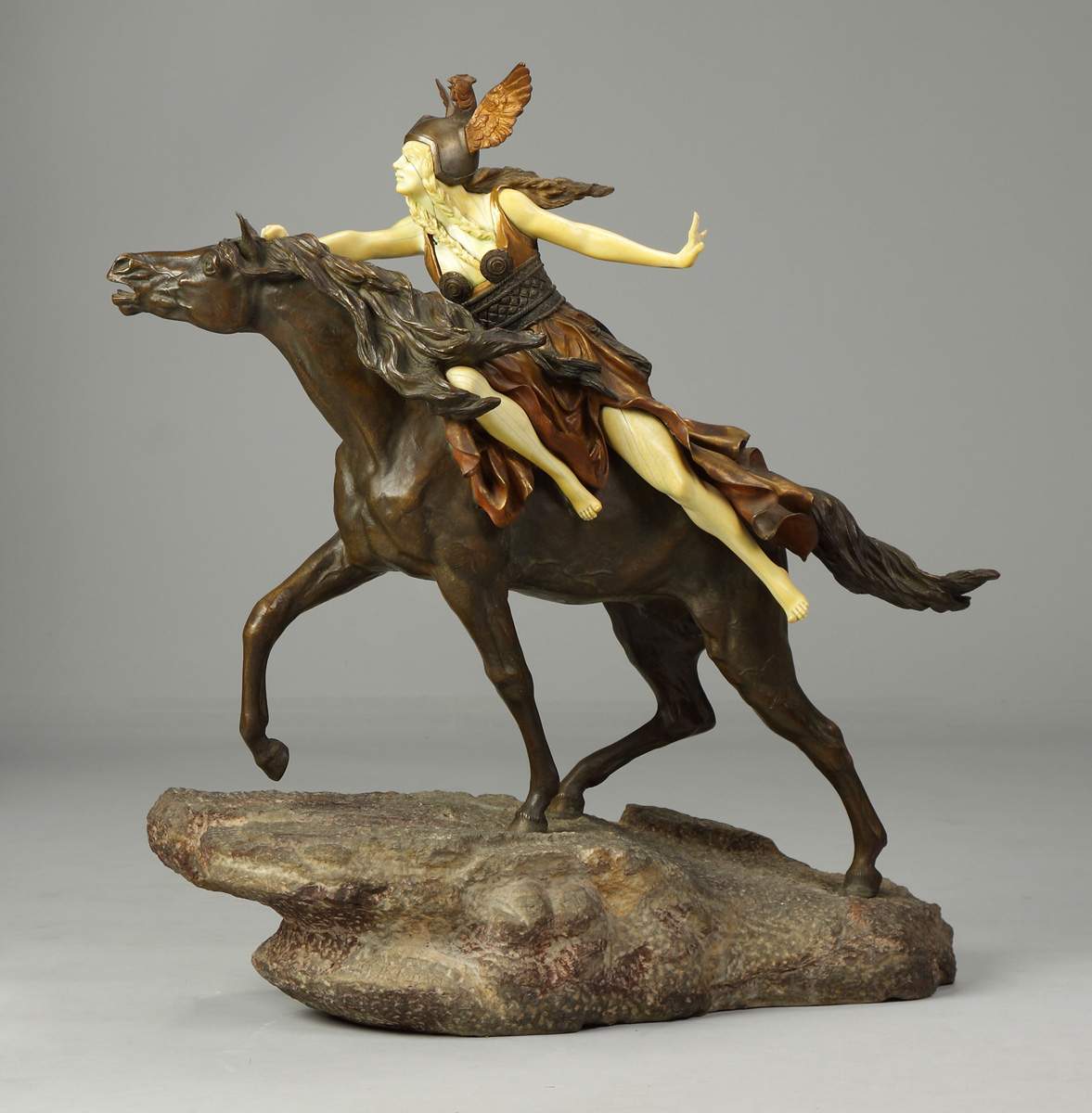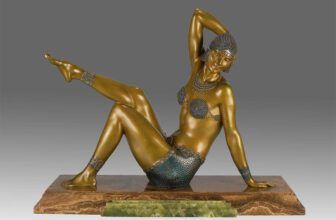
Claire Jeanne Colinet Famous Art Deco Sculpture
In the golden age of Art Deco , a time when elegance met exuberance, and modernity blended seamlessly with tradition , a quiet but immensely talented sculptor named Claire Jeanne Colinet carved her name into the history of decorative arts. Though history often casts its spotlight on her male contemporaries, Colinet’s sculptures have become iconic in their own right. Her mastery in bronze, ivory, and marble revealed not only a refined technical prowess but also a deep emotional resonance, capturing the grace and vitality of the female form and the exotic rhythms of early 20th-century culture.
The Artistic Legacy of Claire Jeanne Colinet
Claire Jeanne Colinet (c. 1880–1950), born in Belgium and later based in France, was a rare woman in a male-dominated art world. Trained under Jef Lambeaux and eventually establishing herself in Paris, she quickly made a name through her contributions to the Art Deco movement, especially between the 1910s and 1930s.
Colinet was renowned for her dynamic female figures , dancers frozen in motion, bathed in sensual energy and exotic detail. These weren’t static representations; they breathed with life, telling stories of cultures and aesthetics that fascinated Europe at the time. Her sculptures, often created using a combination of cold-painted bronze and ivory (chryselephantine), showcased remarkable craftsmanship and captured the zeitgeist of an era defined by liberation, exploration, and aesthetic opulence.
Famous Works: Dancers, Goddesses, and Exotic Inspirations
Among her many works, a few stand out as timeless emblems of the Art Deco period.
1. “Danseuse au Tambourin” (Tambourine Dancer)
Perhaps her most famous and frequently reproduced sculpture, the Tambourine Dancer depicts a lithe woman mid-dance, her body arched and arm outstretched, holding a tambourine high above her head. The motion is palpable. Her flowing garments are intricately detailed, catching the light and drawing the eye across the sculpture’s form. The work celebrates both sensual beauty and the exotic allure that fascinated Parisians in the interwar years.
2. “Danseuse au Voile” (Veiled Dancer)
Another masterpiece, the Veiled Dancer, presents a moment of hidden mystery. The figure, partially obscured by a veil that clings to her form, offers a perfect example of Colinet’s ability to combine eroticism with elegance. It is both provocative and dignified , a fine line Colinet walked with extraordinary finesse.
3. “Arabian Dancer”
This piece reflects Colinet’s fascination with Orientalism, a trend in European art where Middle Eastern, North African, and Asian motifs were used to evoke mystery and opulence. The Arabian Dancer swirls in richly textured robes, her head turned in serene concentration. This sculpture showcases Colinet’s command over motion and texture, using the sculptural medium to evoke sound and rhythm.
4. “Sword Dancer”
The Sword Dancer captures a dramatic, almost theatrical pose. The woman holds a curved scimitar aloft, poised like a warrior goddess. The strength and sensuality she conveys speak to the changing roles of women in the early 20th century , from passive muses to active protagonists in their own stories.
These works, and many others, positioned Claire Jeanne Colinet as a pioneer in portraying strong, dynamic women, often celebrating multicultural influences through her art.
What Was Claire Jeanne Colinet Known For?
Colinet’s reputation rests on three defining qualities:
1. Dynamic Motion and Fluidity
Her sculptures are rarely static. Colinet was a master of kinetic energy, making bronze and ivory seem almost liquid in movement. Her dancers twirl, leap, and pose with such realism that one almost hears the accompanying music.
2. Chryselephantine Technique
She specialized in the chryselephantine technique, a revival of an ancient Greek method combining ivory for the skin and bronze (often cold-painted) for the clothing or accessories. This allowed her to create lifelike tones and textures , a signature of her most valued pieces.
3. Exoticism and Cultural Expression
Colinet’s fascination with the exotic, including themes from the Middle East, Asia, and Africa, aligned with the broader Orientalist trends of the Art Deco movement. But unlike many artists of the time who exoticized these cultures from a Eurocentric gaze, Colinet’s work often conveys genuine admiration and interest.
How Did Colinet Create Her Art Deco Sculptures?
Colinet’s process was both technical and artistic , a dance of materials, form, and detail. Her sculptures often began as detailed clay models, carefully designed to capture posture, proportion, and expression. From there, the pieces were cast using the lost-wax technique, a method that allowed for exceptional detail in the final bronze form.
She then collaborated with ateliers and foundries like Les Neveux de J. Lehmann, who specialized in producing chryselephantine sculptures. The bronze components were cold-painted , a process where paints were applied to metal without heat , to provide vibrant colors and realistic finishes. Ivory, a luxury material, was carved by hand to represent the skin of her figures, giving them lifelike smoothness and glow.
The combination of techniques made her sculptures extremely labor-intensive and expensive to produce. But the result was worth it: mesmerizing objects of beauty that transcended mere decoration to become expressive works of art.
The Value of Colinet’s Art Deco Sculptures Today
Today, Claire Jeanne Colinet’s sculptures are highly sought after by collectors, museums, and auction houses specializing in decorative arts. With a renewed appreciation for female artists and the enduring appeal of Art Deco design, her works have seen significant increases in value over the past few decades.
Here’s an overview of her sculpture valuations in recent years:
High-quality original pieces (especially chryselephantine works with intact ivory and paint) can fetch $20,000 to $150,000 or more at auction, depending on size, condition, and provenance.
Smaller or more common bronze-only pieces often range from $5,000 to $20,000.
Reproductions and posthumous casts, which are less valuable but still attractive to collectors, can sell for $1,000 to $5,000.
For instance, a pristine version of “Danseuse au Tambourin” with its original ivory and coloring sold at Sotheby’s for over $100,000 in a 2019 decorative arts auction. Collectors prize her pieces for their elegance, detail, and historical significance.
Where Can You See Claire Jeanne Colinet’s Sculptures?
While many of Colinet’s works remain in private collections , often held by collectors of Art Deco or Belle Époque decorative arts , you can find her work in a number of museums and galleries, particularly in Europe and North America.
Museums and Institutions
Musée d’Orsay, Paris
Though not part of the permanent collection, Colinet’s works are sometimes featured in special exhibitions relating to women in art or the Art Deco period.The Museum of Decorative Arts, Paris (Musée des Arts Décoratifs)
Home to several Art Nouveau and Art Deco pieces, this museum occasionally features Colinet’s sculptures in thematic exhibitions.The Virginia Museum of Fine Arts (VMFA)
In the United States, the VMFA has showcased her work in the context of 20th-century decorative arts.Private European Galleries
Some of the most exquisite examples of her work reside in exclusive European galleries in Paris, Brussels, and London. Notable auction houses like Christie’s, Sotheby’s, and Bonhams also regularly feature her work in sales and exhibitions.Art Deco Museums and Exhibitions Worldwide
Temporary exhibitions on Art Deco often include Colinet’s work as representative of female sculptors during the movement’s height.
A Feminist Undercurrent in Bronze and Ivory
In the broader context of art history, Claire Jeanne Colinet was not just a sculptor of decorative objects , she was an artist who challenged norms. At a time when women were rarely acknowledged in the arts, she held her own. Her works reflect a world where women were becoming more than muses; they were becoming dancers, warriors, adventurers, and individuals of strength and agency.
There is an undeniable feminist undertone to her art. The power in the poised arm of the Sword Dancer, the joy in the leap of the Tambourine Dancer, the independence of the exotic performer , each sculpture seems to assert: “I am here, I am alive, I matter.”
Rediscovery and Renewed Interest
In the 21st century, there has been a reawakening of interest in women artists of the 19th and early 20th centuries. Claire Jeanne Colinet, once a footnote in auction catalogs, is now being reexamined as a pioneer of Art Deco sculpture.
New generations of collectors are drawn not only to the beauty of her works but also to the story behind them , a story of a woman who sculpted her way into the masculine world of bronze and marble, leaving behind works that are still celebrated, cherished, and collected nearly a century later.
The Enduring Grace of Claire Jeanne Colinet
Claire Jeanne Colinet remains one of Art Deco’s most fascinating sculptors, blending tradition and modernism, sensuality and strength, form and motion. Her dancers, with their flowing garments and striking gestures, continue to captivate audiences and collectors alike.
Whether found on a marble pedestal in a European museum or under glass in a private collector’s salon, her sculptures speak of a time when the world was dancing toward modernity , and Colinet was there, capturing it all in bronze and ivory.
As interest in decorative arts continues to grow, so too does the legacy of Claire Jeanne Colinet. A sculptor ahead of her time, her work endures as a vibrant expression of the Art Deco spirit: graceful, bold, and timeless. image/cottoneauctions.com




